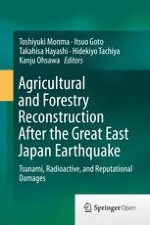13.1 Introduction
13.2 Methods
13.3 Results
13.3.1 Forest Soil
Area | Altitude (m) |
134Cs |
137Cs | Total Cs |
|---|---|---|---|---|
Haramachi-ku | 135 | 13,600 | 19,100 | 32,700 |
Chamaecyparis stand (25 years) | ||||
Haramachi-ku | 120 | 5,250 | 7,460 | 12,710 |
Chamaecyparis stand (25 years) | ||||
Haramachi-ku | 20 | 3,220 | 5,550 | 8,770 |
Quercus acutissima stand
| ||||
Haramachi-ku | 130 | 1,380 | 1,990 | 3,360 |
Clear-cut plot of Quercus serrata
| ||||
Haramachi-ku | 120 | 78 | 177 | 255 |
Clear-cut plot of Cryptomeria
| ||||
Haramachi-ku | 0 | 68 | 143 | 211 |
Minamiebi seaside | ||||
Odaka-ku | 20 | 14,700 | 22,300 | 37,000 |
Cryptomeria stand (40 years) |
13.3.2 Litter Layer
Area | Altitude (m) |
134Cs |
137Cs | Total Cs |
|---|---|---|---|---|
Haramachi-ku | 280 | 78,300 | 143,000 | 221,300 |
Tetsusan Dam | ||||
Haramachi-ku | 120 | 14,180 | 32,400 | 46,580 |
Cryptomeria stand (40 years) | ||||
Haramachi-ku | 80 | 5,340 | 10,800 | 16,140 |
City museum: Abies densiflora stand | ||||
Haramachi-ku | 120 | 3,830 | 6,680 | 10,510 |
Chamaecyparis stand (20 years) | ||||
Odaka-ku | 50 | 113,000 | 177,000 | 290,000 |
Chamaecyparis stand (15 years) | ||||
Odaka-ku | 120 | 53,200 | 93,600 | 146,800 |
Cryptomeria stand (40 years) | ||||
Odaka-ku | 100 | 11,300 | 19,200 | 30,500 |
Cryptomeria stand (40 years) | ||||
Odaka-ku | 120 | 7,380 | 12,300 | 19,680 |
Meeting house | ||||
Odaka-ku | 110 | 697 | 1,100 | 1,797 |
Horse Park: Prunus, Zelkoba
|
13.3.3 Branches and Leaves
Area | Altitude (m) |
134Cs |
137Cs | Total Cs |
|---|---|---|---|---|
Haramachi-ku | 120 | 1,930 | 3,280 | 5,210 |
Cryptomeria (40 years) | ||||
Haramachi-ku | 120 | 2,130 | 3,010 | 5,140 |
Cephalotaxus harringtonia
| ||||
Haramachi-ku | 120 | 1,080 | 2,450 | 3,530 |
Quercus myrsinifolia
| ||||
Haramachi-ku | 120 | 1,270 | 1,690 | 2,960 |
Carpinus tschonoskii
| ||||
Haramachi-ku | 120 | 1,030 | 1,560 | 2,590 |
Zanthoxylum piperitum
| ||||
Haramachi-ku | 120 | 337 | 814 | 1,151 |
Orixa japonica
| ||||
Haramachi-ku | 120 | ND | 171 | 171 |
Padus grayana
| ||||
Odaka-ku | 50 | 14,500 | 21,500 | 36,000 |
Chamaecyparis (15 years) | ||||
Odaka-ku | 120 | 8,030 | 19,000 | 27,030 |
Cryptomeria (40 years) | ||||
Odaka-ku | 50 | 4,180 | 6,030 | 10,210 |
Callicarpa japonica
| ||||
Odaka-ku | 50 | 1,984 | 3,419 | 5,403 |
Acer palmatum
|
13.3.4 Bark and Wood of Standing Trees
Altitude (m) | Bark | Xylem | Xylem/bark | |||||
|---|---|---|---|---|---|---|---|---|
134Cs |
137Cs | Total Cs |
134Cs |
137Cs | Total Cs | |||
Haramachi-ku | 60 | 2,187 | 2,275 | 4,462 | 1,358 | 1,654 | 3,012 | 67.5 % |
Quercus serrata
| ||||||||
Odaka-ku | 20 | 233 | 249 | 482 | 144 | 150 | 294 | 61.0 % |
Quercus serrata no. 1 | ||||||||
Odaka-ku | 20 | 362 | 341 | 703 | 157 | 184 | 341 | 48.5 % |
Quercus serrata no. 2 | ||||||||
Odaka-ku | 20 | 719 | 1,213 | 1,932 | 4,258 | 762 | 5,020 | 63.1 % |
Quercus serrata no. 3 | ||||||||
Odaka-ku | 50 | 13,418 | 15,418 | 28,836 | 7,619 | 9,418 | 17,037 | 59.0 % |
Quercus serrata
| ||||||||
13.3.5 Quercus serrata Mushroom Bed Logs Outdoors
Altitude (m) | Bark | Xylem | ||||||
|---|---|---|---|---|---|---|---|---|
134Cs |
137Cs | Total Cs |
134Cs |
137Cs | Total Cs | Xylem/bark | ||
Haramachi-ku | 60 | 2,187 | 2,275 | 4,462 | 1,358 | 1,654 | 3,012 | 67.5 % |
Quercus serrata
| ||||||||
Odaka-ku | 20 | 233 | 249 | 482 | 144 | 150 | 294 | 61.0 % |
Quercus serrata no. 1 | ||||||||
Odaka-ku | 20 | 362 | 341 | 703 | 157 | 184 | 341 | 48.5 % |
Quercus serrata no. 2 | ||||||||
Odaka-ku | 20 | 719 | 1,213 | 1,932 | 4,258 | 762 | 5,020 | 63.1 % |
Quercus serrata no. 3 | ||||||||
Odaka-ku | 50 | 13,418 | 15,418 | 28,836 | 7,619 | 9,418 | 17,037 | 59.0 % |
Quercus serrata
| ||||||||
13.3.6 Herbaceous Vegetation and Sprouts in Clear-Cut Plots
134Cs |
137Cs | Total Cs | |
|---|---|---|---|
Follopia japonica
| ND | ND | ND |
Macleoya cordata
| ND | ND | ND |
Lamiaceae
| 3,320 | 4,720 | 8,040 |
Male flower of Castanea crenata
| 306 | 553 | 859 |
Sprout of Quercus serrata no. 1 | 663 | 1,000 | 1,663 |
Sprout of Quercus serrata no. 2 | 266 | 281 | 547 |
Sprout of Quercus serrata no. 3 | 257 | 295 | 552 |
